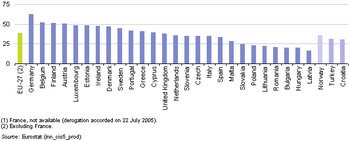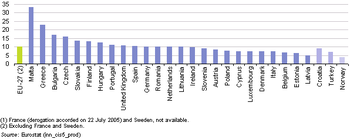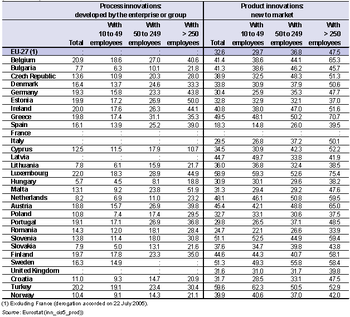Archive:Innovation statistics
- Data from September 2009, most recent data: Further Eurostat information, Main tables and Database.
This article looks at the state of innovation in the European Union (EU) by presenting data on where it is done, how many enterprises are involved, what types of entreprises they are and the share of innovative products and services. By placing competitiveness at the heart of the EU political agenda, the renewed Lisbon process aims to make Europe a more attractive place to invest, by boosting entrepreneurial initiative and creating a productive environment where innovation capacity can grow and develop.
Main statistical findings
In 2006, some 38.9 % of EU-27 enterprises were considered as innovative. The highest propensity to innovate was recorded in Germany (62.6 %), while Belgium, Finland and Austria also reported that more than one in every two enterprises were innovative. At the other end of the range, the lowest propensity to innovate was registered by enterprises in Latvia (16.2 %), while Hungary, Bulgaria, Romania, Lithuania, Poland and Slovakia also reported that fewer than one in four enterprises innovated. Note that large enterprises tend to innovate more than small and medium-sized enterprises (SMEs) and as such these figures may, at least to some degree, reflect the enterprise structure of each economy.
New or significantly improved products contributed a relatively small proportion of total turnover among innovative enterprises in 2006, some 10.0 % for the EU-27 in 2006, with 11 of the Member States reporting single-digit shares. These products did however account for a much higher percentage of sales in the Czech Republic (16.0 %), Bulgaria (17.0 %), Greece (22.8 %) and Malta (where their relative importance rose to 33.4 % of turnover).
Almost half (47.5 %) of the large enterprises in the EU-27 (with 250 or more employees) brought product innovations to market in 2006, compared with 36.8 % of medium-sized enterprises (50 to 249 employees) and 29.7 % of small enterprises (10 to 49 employees). A similar size class breakdown for process innovations that are developed within the enterprise also showed that large innovative enterprises were also more likely to introduce processes innovations.
Data sources and availability
The Community innovation survey (CIS) collects information about both product and process innovation and organisational and marketing innovations. The legal basis for the collection of these statistics is Regulation 1450/2004 of 13 August 2004 implementing Decision Np 1608/2003/EC concerning the production and development of Community statistics on innovation. Note that the European Commission accorded on 22 July 2005 a derogation to France concerning CIS 2006 data. As a result, CIS data for France for 2006 only cover the manufacturing sector (NACE Rev. 1.1 Section D) for enterprises with more than 50 employees.
Innovations are based on the results of new technological developments, new combinations of existing technology, or the use of other knowledge acquired (by the enterprise). For the purpose of the Community innovation survey (CIS) an innovation is defined as a new or significantly improved product (good or service) introduced to the market, or the introduction within an enterprise of a new or significantly improved process. Such innovations may be developed by the innovating enterprise or by another enterprise. However, purely selling innovations wholly produced and developed by other enterprises is not included as an innovation activity, nor is introducing products with purely aesthetic changes. Innovations should therefore be new to the enterprise concerned: for product innovations they do not necessarily have to be new to the market, and for process innovations the enterprise does not necessarily have to be the first one to have introduced the process.
Enterprises with innovation activity include all types of innovator, namely product innovators, process innovators, as well as enterprises with only on-going and/or abandoned innovation activities. Enterprises may cooperate with other parties (for example suppliers, competitors, customers, educational/research establishments) when engaging in an innovative activity. The proportion of enterprises with innovation activity is also referred to as the propensity to innovate.
Context
Innovation (ideas applied successfully in practice) provides the potential for society to tackle some of the world’s major issues – for example, climate change, depleted energy resources, disease and illness.
Europe has a long-standing tradition of producing inventions. However, commentators often focus on an entrepreneurial gap in order to explain why some ideas for new products or services do not become a success in the marketplace, or why other ideas relating to new processes do not get implemented, thereby surrendering the opportunity to make efficiency gains on production lines or within industrial organisations. Hence, while Europe is very good at producing ideas, it is not as good at bringing them to market; as such, EU policy in this field increasingly aims to provide more focus to industry-driven, applied R & D.
Education is another area seen as key to developing an innovation-orientated society, through the acquisition of entrepreneurial, managerial, scientific, mathematical and foreign-language skills, as well as digital literacy. Policymakers express concern at the numbers of science and technology graduates who directly apply their education once they move into the labour market, while a lack of job mobility between universities and industry may potentially hinder the transfer of ideas, thereby reducing the EU’s innovation performance (see Careers of doctorate holders and R & D personnel ).
Globalization and the rising economic power of developing nations have resulted in some European enterprises needing to become more innovative just to maintain their competitive position. The European Commission is trying to make sure that innovation is thoroughly understood: indeed, 2009 was the European year of creativity and innovation. The EU seeks to contribute to greater competitiveness, sustainability and job creation, through the promotion of innovation (among others):
- providing financial support for innovators;
- providing innovation support services (notably for start-ups);
- encouraging venture capital;
- developing and testing new forms of business support;
- facilitating transnational cooperation;
- mobilizing resources for the creation of a European innovation space.
By placing competitiveness at the heart of the European political agenda, the renewed Lisbon process aims to make Europe a more attractive place to invest, by boosting entrepreneurial initiative and creating a productive environment where innovation capacity can grow and develop. With this in mind, on 29 October 2006, the European Parliament and the Council adopted a Decision 1639/2006/CE establishing a competitiveness and innovation framework programme (CIP) for the period 2007-2013 .
The European Council called for a plan on innovation in December 2008 and these reflections on future innovation policy are likely to be part of a wider debate on the Lisbon Strategy post-2010 (EU 2020). This Council initiative provided the basis for a period of public consultation and business debate, for example, a first roundtable on future European innovation policy was held in June 2009; three months later the European Commission adopted a Communication ‘reviewing Community innovation policy in a changing world’.
As part of these on-going reforms, the EU has set up a European Institute of Innovation and Technology (EIT); this is an independent Community body whose mission is to address Europe’s innovation gap through the ‘stimulation of world-leading innovation’, such that Europe may capitalise fully on its innovation capacity and the capability of its actors (higher education staff, researchers, business leaders and entrepreneurs) through the creation of knowledge and innovation communities (KICs).
Further Eurostat information
Publications
- Innovation in Europe – results for the EU, Iceland and Norway - Data 1998–2001
- Science, technology and innovation in Europe
- Science, technology and innovation in Europe – 2008 edition pocketbook
Main tables
- Science and technology, see:
- Community innovation survey
- Turnover from innovation
- Effects of innovation on material and energy efficiency
Database
- Science and technology, see:
- Community innovation survey
- Results of the second community innovation survey
- Results of the third community innovation survey
- Results of the fourth community innovation survey
- Results of the community innovation survey 2006
- Results of the first community innovation light survey - CIS light
External links
- European Commission - Competitiveness and Innovation Framework Programme (CIP)
- European Innovation Scoreboard 2008 (EIS)
- The Lisbon council - making Europe fit for the future
- OECD - Science and innovation - Statistics
- Regional Innovation Scoreboard (RIS) 2009


